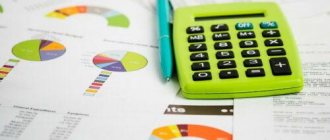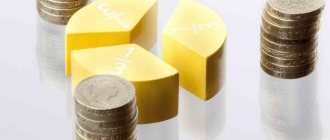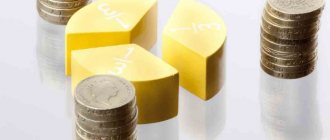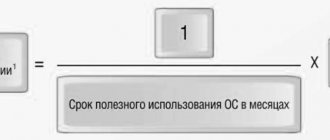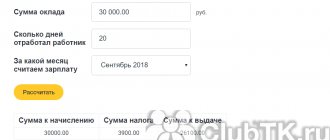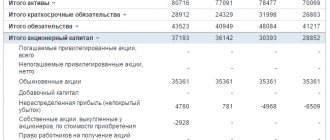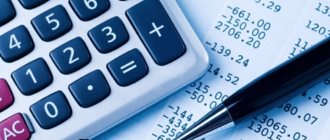The company's assets include the cost expression of the resources that support the production process of the enterprise. Assets include:
- Non-current assets (structures, buildings, machinery and equipment, transport, etc.),
- Working capital (cash, accounts receivable, short-term investment, etc.).
Asset accounting is mandatory for most Russian enterprises. All assets are concentrated on the left side of the balance sheet and are divided according to their purpose:
- The first section of the balance sheet is represented by non-current assets (fixed assets and intangible assets), which are accounted for in accordance with their residual value less depreciation (line 1100 of the balance sheet);
- The second section of the balance sheet is represented by working capital, which is directly involved in the production process (line 1200 of the balance sheet).
Calculation of the average annual cost of fixed assets
If we are talking about how to find the average annual cost of fixed assets, then we can use several methods. In this case, the choice of method for calculating the operating system directly depends on the purpose of the calculation and the required accuracy that should be obtained in the end. Thus, the calculation formula below does not imply OS I/O. This is practiced when special precision is not necessary.
Basic formulas for calculating the cost of operating systems
You can calculate the average annual reporting of fixed assets in the following way:
Average_price = (Price (year) + Price (year))/2, where Price (year) and Price (year) – the price of fixed assets, as of January 1 and 31 December of the year for which the calculation is made.
It is worth noting that the price on December 31 can be calculated using the following formula:
Price (k.g.) = Price (n.g.)+Price (input) - Price (select), where Price (select) and (input) is the price of fixed assets directly entered and written off throughout the year.
There are several methods for calculating the cost of an OS.
Calculation of the average annual full accounting value of fixed assets
If it is necessary to obtain more accurate calculations, it is also necessary to take into account the month in which the fixed assets were written off or introduced. To find out how to calculate the average annual total accounting value of fixed assets, we turn to using one of several formulas that we will consider next. The most popular formula that is used when calculating the operating system indicator (capital productivity, capital intensity, etc.) looks like this: St. average = St. (n.g.) + P1/12xSt. (input) - P2/12xSt. (select), where P1 and P2 are the total number of months that have passed since the date of entry and write-off fixed assets
St. average = St. (n.g.) + P1/12xSt. (input) - P2/12xSt. (select), where P1 and P2 are the total number of months that have passed since the date of entry and write-off fixed assets.
Also, here is the average chronological formula:
St-st-st average=[(St-st-st(1n.m)+St-st-st(1k.m))/2+(St-st-st(2n.m)+St-st-st(2k.m))/2… +(St-st (Nn.m) + St-st (Nk.m))/2] /12, where:
- st-st (1n.m), St-st (2n.m),…St-st (Nn.m) – the price of fixed assets at the beginning of the 1st, 2nd, Nth month;
- st-st (1k.m), St-st (2k.m),…St-st (Nk.m) – the price of fixed assets at the end of the 1st, 2nd, Nth month.
Property tax calculation
To carry out calculations when calculating company property tax, the following formula is used:
Average St. = (St. (n1) + St. (n2) +…+ St. (nn) + St. (k)) /13, where
- st-st (n1), St-st (n2)… St-st (nn) – residual price of fixed assets on the first day of the 1st, 2nd... month of the tax period;
- st-st(k) – residual price of fixed assets as of the last dates of the tax period;
- 13 is the number obtained by adding one to the 12 months of the tax period.
For accounting, the period of use of fixed assets must be at least 12 months
Calculation of the average annual cost of fixed assets on the balance sheet
The following formula will help you learn how to calculate the average annual cost of fixed assets on the balance sheet. It looks like:
Fo = Fp (balance sheet) + (Fvv * KR) / 12 – (Fl * (12 - P)) / 12, where
- FP (balance sheet), - balance sheet of the OS;
- Fvv, - funds introduced;
- KR, - total number of months;
- Fl, - Liquidation price;
- P, is the total number of months in which the OS operated during the current year.
The most inaccurate is the method of calculating the cost of fixed assets, which does not take into account the month in which fixed assets were introduced or written off. To achieve the most reliable calculation results, it is necessary to apply one of the formulas that take this month into account. As practice shows, the best option is the average chronological formula. https://www.youtube.com/embed/WVybeRz3PSY
Average number of employees
To calculate the average number of employees, information is required on the number of employees for all days of the period under study, which is recorded in time sheets reflecting the number of employees and the number of hours worked.
The average number of employees per month can be calculated by summing the number of employees for each calendar day and dividing this amount by the number of days in the month.
The average payroll number for a year, six months or quarter is determined in a similar way; the average payroll number for the months of the period is added up and divided by the number of months (three, six, twelve, etc.).
Average chronological
The chronological average is the average level of a series of dynamics, i.e., the average calculated from the totality of indicator values at different moments or periods of time.
Depending on the type of dynamics series, various methods of its calculation are used, namely the calculation of the average chronological interval series and the average chronological moment series.
The average chronological interval (more common) series is the average value of the levels of the interval dynamics series, which is calculated by the formula:
where is the average level of the row;
— level of the dynamics series;
- number of members of the series
As an example, let’s look at data on children’s health institutions in Pskov and the region.
Table. Children's health facilities
| 1995 | 2000 | 2003 | 2004 | 2005 | 2006 | |
| Number of summer health camps | 141 | 358 | 391 | 399 | 410 | 314 |
The series under study is interval, using the average chronological formula we can calculate the average number of health institutions:
institutions.
The average chronological moment series is the average value of the levels of the moment series dynamics. If there is a function expressing the change in a moment indicator over time, then for the time from to the average chronological moment series is equal to:
However, as a rule, statistics do not have continuous observation data available. Therefore, depending on the nature of the change in the indicator and the available data, various calculation methods are used.
Given equal time intervals between the dates for which data are available and a uniform change in the size of the indicator between dates, the average chronological moment series is usually calculated using the formula:
where is the row level;
- the number of all members of the series;
- average level.
If the time periods separating one date from another are not equal, then the average chronological moment series is calculated using the weighted arithmetic average formula, the weights of which are taken as the time intervals between dates, i.e., according to the formula:
where is the time during which a given level of the series remained unchanged.
Why is the average annual value of assets calculated?
Here are two answers to this question.
First answer. The balance sheet shows a picture of the life of the enterprise at the moment, that is, for a specific day and even for a specific hour. When you look at an asset, you see what property the company has at the reporting date. The situation will definitely change tomorrow:
- new debts of counterparties will appear, and some of the old debts will be repaid;
- new goods will be purchased, and those that were in the warehouse will be written off due to sale, damage or shortage;
- the day of salary payment will come, and a cash outflow will be formed based on this, etc.
If an analyst decides to smooth out all such jumps and understand what the average valuation of property is for a certain period, then the indicator of the average annual value of assets will come to his aid.
It turns out that the first reason for the calculation is to level out fluctuations in the value of property, and on this basis make a correct comparison across different years.
Second answer. Let's compare what the table headers look like for the balance sheet and the income statement.
The difference is obvious. All indicators of income, expenses and financial results, in contrast to balance sheet values, are calculated cumulatively for a certain period. Proceeds are not available as of December 31, 2021. It is formed over the year as a whole. Or, let’s say, for a month, a quarter, a half year.
What does this understanding provide? The opportunity to understand, and therefore not to forget, the rule: if data from the balance sheet and the income statement are used simultaneously in one calculation formula, then the former are taken in an average annual value. If this is not done, then it turns out that the analyst is trying to link together the momentary (point) assessment with the assessment for the period. It is not correct.
Where does the average annual value of assets come into play in financial analysis? For example, in profitability and turnover formulas, and also in factor models. For convenience, we have collected some of these indicators and factor analysis formulas in a table. All of them relate, first of all, to the average annual value of assets as a whole. However, turnover and profitability are calculated in the same way for non-current, current and net assets.
Table 2 – Where the average annual value of assets comes in handy
| Indicator/ratio | Formula |
| 1 Asset turnover (profitability) | Revenue ÷ Average annual asset value |
| 2 Return on assets | Net profit ÷ Average annual asset value |
| 3 Two- and three-factor DuPont models | Return on assets = Return on sales × Asset turnover |
| Return on Equity = Return on Sales × Asset Turnover × Equity Multiplier | |
| 4 “Golden” rule of enterprise economics | 100% |
Average annual asset value: all formulas
What information is not included in the balance sheet asset
In reality, the average annual value of a firm's assets according to accounting data is likely greater than what is shown on the balance sheet. How is this possible if the balance is compiled according to the ledger accounts? The reason is the so-called regulatory accounts, which reduce the amounts on the balance sheet lines. We will not go into the intricacies of accounting, but simply name what exactly does not fall into the balance sheet, and therefore does not form the average annual value of assets. This will be part of the cost:
- Fixed assets and intangible assets, which corresponds to the depreciation accrued on them;
- Materials, goods, finished products, for which a reserve has been created to reduce the cost of material assets. Such a reserve is created when inventories have hopelessly lost their original characteristics, become obsolete, or become much cheaper than the cost of acquisition;
- Goods in retail trade organizations, when they are accounted for at sales prices. We are talking about that part of the cost that is formed by the trade margin. The markup is the income that has not yet been earned by the enterprise from the future sale of these goods. It is precisely because of its “unearnedness” that it is excluded from the asset;
- Accounts receivable in the amount of the provision for doubtful debts. If the receivables include debts for which the repayment period has expired, there is no collateral and there is a high probability of non-repayment, then a reserve is created. Its value is excluded from the balance sheet, and, therefore, from the average annual value of assets. This is done so that users of the enterprise’s financial statements see the assessment of funds in the calculations as close to reality as possible. That is, the amount that the organization actually expects to be received in the near future and in which there are no bad debts.
Exceeding the standard
If you calculate the share of working capital in assets and compare the result with the standard, you can conclude that it is advisable to distribute property among balance sheet items. Significant excess of coefficients above the established values is not encouraged. The accumulation of funds in inventories and accounts receivable leads to an increase in the turnover cycle.
Having studied such a concept as the share of working capital in assets, it is possible to conduct a correct analysis of the balance sheet structure. Based on the data obtained, the main indicators of liquidity and availability of own sources of financing are optimized. This increases the stability of the organization and leads to higher profit levels.
News and society Efficiency of use of working capital. Economic essence, coefficients
Any enterprise has a certain reserve of working capital. They consist of circulation funds (products in the warehouse, shipped products, etc.) and circulating production assets (materials, both basic and auxiliary...
Finance Liquidity ratio: balance sheet formula and standard value
One of the indicators of a company's performance is the level of liquidity. It assesses the creditworthiness of the organization, its ability to fully pay off its obligations on time. More details about how...
News and society Return on working capital: ratio, formula, analysis
The management of any company is obliged to monitor the performance indicators of the organization of financial and economic activities. The net profit of the enterprise and its stability depend on this. An important step about…
Education Formula and methods for determining an enterprise's need for working capital
Every enterprise strives to increase the efficiency of using its capital. The profitability of the organization, its market value and stable development in the future depend on this. It is for this reason that I comply…
Finance Cash on the balance sheet is the most liquid asset category
Cash is what all organizations involved in the sale of goods and services carry out their activities for. Making a profit is the main goal of any business company in market conditions...
Business Turnover Ratio: Formula. Asset turnover ratio: calculation formula
The management of any enterprise, as well as its investors and creditors, are interested in the company’s performance indicators. To conduct a comprehensive analysis, various techniques are used. In mandatory...
Business Turnover ratio and working capital load
From the course “Enterprise Economics”, every graduate of the Faculty of Economics knows that working capital is a certain combination of various production assets and non-natural circulation funds...
Marketing What non-current assets include and their accounting
Assets are understood as all objects on the balance sheet of an enterprise. They are recorded in the asset accounts, in the debit column. Therefore, the total value of the enterprise’s property must be judged by the debit of active accounts.
News and society Working capital ratio: what it is and how to calculate
The working capital ratio reveals whether the enterprise has enough of its own funds, which are necessary for its financial stability. Availability of capital by the business entity…
Education Working capital turnover ratio
In a market economy, the stability of a company’s position is largely due to its activity in work, which depends on business reputation, efficient use of resources, breadth of markets,...
Current assets on the balance sheet
]]>]]>
The resource potential of the company, ensuring the continuity of the work process, is called working capital.
It is necessary in the current activities of the company, is introduced once into each production cycle, and, losing its material and natural form, transfers its value to the released product.
Skipping the strict economic definition, let’s figure out which company assets are current, how they are classified and which balance sheet lines they occupy.
The concept of working capital
So, objects of labor directly used in the production process are classified as working capital. The most common assets in this block of property are monetary and material resources, which are the main participants in the release of the product. In doing so, they go through several stages:
- Inventory supplies are purchased with cash or funds from a bank account;
- At the production stage, materials and raw materials change their quality characteristics, being processed and transferring their value into the price of the product;
- At the marketing stage, the product is sold and regains its monetary form, but at the same time the profit from the sale is added to the invested value.
Thus, the technological production cycle is constantly reproduced. In addition to monetary and material resources, the company’s balance sheet also contains other current assets, which are also characterized by rapid turnover.
What is included in current assets on the balance sheet?
Working capital in the balance sheet is allocated to the 2nd section with the same name. This asset section of the balance sheet reflects current assets by line:
| Asset name | № lines |
| Reserves | 1210 |
| VAT on purchased assets | 1220 |
| Accounts receivable | 1230 |
| Financial investments | 1240 |
| Cash and cash equivalents | 1250 |
| Other current assets | 1260 |
| The total value of the company's OA | 1200 |
Let us briefly describe each group of listed assets:
- The inventory block, in addition to those used as raw materials in the production of products, combines the following assets:
– costs in work in progress, since the technical process in the company does not stop at the end of the month;
– farmed animals that are products of animal husbandry;
– finished (not yet sold) products stored in a warehouse;
– shipped goods, i.e. on the way to the buyer;
– deferred expenses (FPR);
- other supplies.
- VAT on purchased assets as of the reporting date represents the balance of tax not accepted for deduction.
- Accounts receivable is the total amount of debts owed to the company, but not received at the balance sheet date.
- Financial investments (except cash equivalents) are investments with a maturity of up to a year. These may include securities - debt or issued by commercial, municipal or government agencies, deposits in management companies of other companies or loans issued to them, deposits in banks or receivables acquired under an assignment of rights of claim;
- Cash in hand and in bank accounts;
- Other current assets on the balance sheet are the value of assets that are not reflected in other lines of the balance sheet. For example, among others, they take into account the cost of missing inventory items, for which there is no decision to write off the losses or the culprits, VAT on advances, the amount of overpaid taxes and fines, for which no decision has been made on offset or refund, etc.
The final amount of working capital in the balance sheet is line 1200. It accumulates information about the size of the company’s working capital.
Classification of working capital
Current assets are classified depending on their characteristics. For example, they can be divided as follows
- by source of education:
- own working capital (balance sheet formula = line 1300 – line 1100), formed from company funds;
- acquired with borrowed capital (usually when financial difficulties arise);
- by degree of controllability:
- normalized, i.e. ensuring the continuity of the production process (inventory production, RBP, work in progress, finished goods);
- non-standardized, that is, in the sphere of circulation (except for finished products) and not affecting the production process (cash, accounts receivable, shipped goods).
If necessary, current assets are classified according to other criteria.
Return on current assets
The mere presence of current assets on the balance sheet only informs the user about their size. Having analyzed the values of financial and other current assets in the balance sheet by period, the economist can determine the level of provision of the technological cycle with appropriate resources, optimize the structure of consumed funds, and get rid of illiquid inventories.
One of the important indicators of rational use of working capital and assessment of company productivity is profitability.
It is determined by the ratio of the amount of profit received to the amount of the average annual cost of operating assets (the amount of operating assets at the beginning and end of the year, divided by 2), and it demonstrates the company’s ability to provide a volume of profit related to the working capital used. The higher the value obtained, the more efficiently the OA are used.
Current assets on the balance sheet: example
Based on the initial balance sheet data, we will consider the dynamics of changes in the indicators of the lines of current assets and calculate the profitability of OA if the profit in 2021 amounted to 600 thousand rubles, and in 2021 – 800 thousand rubles:
| Strings | Finally | Changes for 2021 | Profitability |
| 2016 | 2017 | 2018 |
Source: https://spmag.ru/articles/oborotnye-aktivy-v-balanse
Valuation of enterprise assets. Formula for calculating the indicator
Asset turnover ratio (ATR) is the ratio of revenue to the average value of assets.
In simple words: how many complete production cycles were there during the analyzed period. The indicator is used to assess the turnover rate.
More information about property turnover can be seen in the video:
The formula for calculation is as follows:
Sales revenue is the amount of funds that an enterprise received from the sale of its products (services, works). This may be cash or property receipts.
Average asset value (AVA) is ½ the amount of the enterprise's funds at the beginning (ANP) and end of the period (ACP). Calculated using the formula:
COAs are found over a specific period: usually a year, but can also be a quarter or a month. And the data for calculating this financial indicator must be taken for the same time.
For example, you need to find out the company’s COA for 2021 with the following data (download the table in Excel):
Table 1. Example of calculating the indicator for 1 month
| Index | 2017 |
| Sales revenue | 1 450 |
| Asset value at the beginning of the period | 1 027 |
| Asset value at the end of the period | 965 |
| Average asset value | 996 |
| Asset turnover ratio | 1,455823 |
Thus, the company's KOA for 2021 was 1.45. That is, during these 12 months the company completed 1.45 production cycles, and revenue was 1.45 times the cost of funds.
Balance sheet calculation:
- Art. 2110 – line 2110 from form 2.
- Art. 1600 ng – line 1600 at the beginning of the year from form 1.
- Art. 1600 kg – line 1600 at the end of the year from form 1.
Composition of assets and where to look
Any specialist who has ever dealt with accounting knows the words “balance sheet” and “organizational assets.” If we explain their meaning in accessible language, it turns out that the book value of assets
- this is a certain number of means and benefits that can be expressed in monetary terms.
Speaking in the language of accountants, what is the book value of an enterprise’s assets?
, then this is the amount of all the company’s assets in cash, which is clearly shown in the accounting. balance.
Assets can be:
- non-current - they are summarized in line 1100 of the balance sheet;
- negotiable – written in line 1200.
All main types of property and intangible assets are classified as non-current. They appear on the balance sheet at their residual value (at which they were received/purchased, taking into account subsequent aging, wear and tear and revaluation carried out by the company).
Working capital includes assets, the use of which in the activities of an enterprise to achieve financial success is quite frequent. They are involved for 12 months or another established cycle. These include:
- materials needed for production;
- debts of debtors to the company;
- monetary assets and the like;
- VAT on property acquired by the enterprise;
- financial investments, etc.
It is not difficult to find the book value of assets: this is the line
1600 in balance. It shows the amount of both current and non-current assets.
Thus, there is only one option where to look at the book value of assets in the balance sheet
: it is registered in line 1600 of the balance sheet.
Why is the value of company property assessed?
Beginning entrepreneurs have little understanding of economics and accounting, so they often hire accountants to manage their affairs. But not every entrepreneur can afford the services of a professional: the average salary of a good accountant is 30–40 thousand rubles, plus he needs to provide a workplace, pay taxes and fees for it. Therefore, if you have free time and desire, an entrepreneur can get comfortable on his own, saving serious money. Accounting for the value of assets is carried out for the following reasons:
- The entrepreneur receives information about the actual costs that were made to transfer the asset to the OS.
- The entrepreneur understands what costs are associated with the disposal of fixed assets for one reason or another, as well as what profit comes from the sale of fixed assets.
- It is possible to determine how much costs are required to maintain assets and whether they are worthwhile. It will be possible to calculate the numerical and percentage ratio of the costs of repairs, maintenance, storage of fixed assets and other indicators.
- Knowing the exact numbers, an entrepreneur can control the safety of his assets.
- Creation of correct reporting that the inspection authorities will not find fault with. The reporting includes many parameters: when and in what volume fixed assets were received, how they are used, how they are depreciated, how they are disposed of and what is their residual value, how much does their support cost, is it possible to write off, etc.
Average annual assets are used to calculate property tax.
Accordingly, based on the accounting, the entrepreneur or his accountant prepares a report to the Federal Tax Service. Before you learn how to calculate the average value of assets, let's look at what types of assets there are and how they are classified. Usually, to calculate the cost of fixed assets, a calculation technology is used, which includes all factors affecting the assets. The following calculation methods are used:
- Finding the primary cost. It is calculated when the asset is placed on the balance sheet. To the total price of the asset are usually added the costs that need to be made for transportation, commissioning, and the creation of a place or structure for storing fixed assets.
- Finding the restored value. It is calculated after certain actions aimed at restoration have been performed on the asset: repair, reconstruction, restoration, etc.
- Finding the residual value. To find this parameter, you need to know the primary cost. Then the current value is subtracted from it, which is calculated by reducing the PS by the amount of depreciation.
- Finding book value. This ratio shows the current price of fixed assets that are recorded on the company's balance sheet. The book price is directly linked to the residual value, while it changes over time due to the obsolescence of assets.
- Finding the liquidation price. This ratio shows exactly how much your fixed assets will cost when they are removed from the company’s balance sheet or when deregistered. If an asset is sold, depreciation is subtracted from the initial price and the resulting cost is assigned.
- Finding the market price. If the liquidation price shows the price, which is calculated by subtracting depreciation from the initial costs of the asset, then the market price is calculated by studying prices on the market and finding the average cost of an analogue of the asset.
If you have calculated the above values, you will be able to calculate the average annual value of assets (the formula for the balance sheet will be given a little lower). Valuation of fixed assets allows you to correctly analyze the dynamics of assets, keep records in accordance with legal requirements, and also submit declarations and reports to regulatory authorities.
Calculation of the value of assets according to the balance sheet
They make it possible to partially predict the result of economic activity and determine the need for certain types of resources and capital.
There is one very revealing technique. It is based on the calculation of the average annual value of assets. The output is a conclusion about the type of development of your organization (extensive or intensive). Download the Excel file and simply plug in the numbers from your company’s reporting.
The Ministry of Finance wants to introduce a single advance payment for legal entities (money is transferred to a single cash register, and then the tax authorities “distribute” it among taxes). Is it convenient?
Admission turnover ratio value
The formula for the turnover ratio for admission, calculated for various periods, tracks and controls the personnel situation for the company as a whole and for each of its divisions (department).
The personnel service, analyzing the turnover indicator for admission, can timely develop a set of measures in the following areas:
- Reduce staff turnover,
- Increase employee motivation,
- Carry out the process of movement of workers within the enterprise.
By regularly calculating the hiring turnover indicator, you can obtain accurate information about the movement and dynamics of hiring workers at the enterprise.
Using the formula for the recruitment turnover ratio, the growth rate of new personnel recruitment and its necessity, and the correspondence of the increase in new employees to the real needs of the enterprise are assessed.
Most often, this indicator is used when compared with the employee attrition rate. If a high hiring turnover rate is accompanied by a high attrition rate, then we speak of high staff turnover. HR workers, through the use of simple calculations, have the opportunity to analyze the reasons and dynamics of the movement of employees in the company.
How to find average assets
Linking current assets to sales increases the value of their market value (usually their net realizable value). Thus, although the market price of fixed assets is usually neglected in historical cost accounting, it is not ignored for current assets. First, the notes to the balance sheet can show the market value of some current assets. Secondly, the assessment of balance sheet indicators is carried out using the rule of the lower of two values: cost and market value. During periods of rising prices, this usually results in the use of the original cost. However, the ever-implicit possibility of a lower market value is an example of accounting's inherent principle of conservatism. In British balance sheets, current assets are shown after fixed capital, and also in order of increasing liquidity (the last heading is “Cash”). American balance sheets usually begin with current assets. The expression net current assets (or “working capital”) means current assets minus current liabilities. The ratio of current assets to current liabilities is called the liquidity ratio.
Current assets are enterprise resources that are not intended for long-term use. These include inventories and expenses, short-term accounts receivable and other liquid assets that can be converted into cash within a production cycle or year. You can find current assets using the company's financial statements.
1. Open the company’s balance sheet as of the date you need. The value of current assets at the beginning and end of the period is indicated on line 290 (total of section II of the balance sheet). Determine their dynamics over the period by calculating the difference between these figures.
2. Calculate the average value of current assets for the period using the formula: Ats = (At1+At2)/2, where:
At1 - current assets of the enterprise at the beginning of the period; At2 - current assets of the enterprise at the end of the period. You can then analyze the effectiveness of their use.
3. Calculate the profitability of the enterprise’s assets using the formula: Pa = P / Ats x 100%, where:
— P — net profit for the analyzed period; — ATS is the average value of the enterprise’s current assets for the period.
Determine the amount of net profit of the enterprise on line 190 of the “Profit and Loss Statement”.
4. Divide the amount of the enterprise's net profit by the calculated average value of the enterprise's assets.
By multiplying the resulting coefficient by 100%, you obtain the return on assets of the enterprise for the analyzed period. This indicator characterizes the amount of profit per each ruble of their value. It is considered optimal if it is 18-20%.
5. Find the turnover of current assets using the formula:
Ob = (V/Ats) * Kdn, where:
B - sales revenue for the reporting period (excluding VAT); ATS - the average value of the current assets of the enterprise; Kdn - number of days of the reporting period.
Take revenue from the income statement for the analyzed period. Dividing it by the average value of current assets, multiply the resulting figure by the number of days in the reporting period.
6. Calculate the turnover of current assets for previous reporting periods, analyze the dynamics of changes. The lower the score, the better. The economic efficiency of reducing the asset turnover period is expressed in the release of additional funds from circulation and, as a result, in increasing the profit of the enterprise.
7. Keep in mind that as the turnover period decreases, less inventory is required. At the same time, storage costs are reduced. Accordingly, a slowdown in turnover leads to an increase in the cost of current assets and additional costs. Thus, timely calculation and analysis of the state of assets will allow making the right decisions to manage their use.
Other approaches to calculating the average value of assets per line on the balance sheet
The above formulas for calculating the average annual value of assets by line on the balance sheet are the most common option. But what if you need to calculate a figure for a period that is longer than one year? Or, for example, don’t you like the fact that to calculate the annual average, only data for the beginning and end of the year is taken and the intermediate values between these dates are not affected at all? After all, this directly affects the accuracy of the final indicator.
Obviously, judging the average value of assets for the year by only two values is like trying to get through to someone and only knowing two digits of their phone number.
In such cases, the average chronological formula for a moment series will help:
X – the average annual value of any indicator, including assets in general, as well as non-current, current and net assets;
n – number of reporting dates for which calculations are made.
For example, you decided to use one balance sheet to calculate the average annual value of assets (A) for two years at once - 2017 and 2018. Then the formula is interpreted as follows:
And if your organization generates a balance sheet monthly (in theory, this is how it should be), and you decide to calculate the average value of assets based on all twelve months of the reporting year, then use the formula:
How to correctly calculate tax deductions
To correctly calculate the average value of assets (a line in the balance sheet to find the desired value of 1150), you need to use the formula CC = (St (n1) + St (n2) + St (nn) + St (k))/13. In this formula, CC is the average cost, St (n1) and further is the cost at the beginning of a new month of the reporting period, St (k) is the price of the asset at the end of the period, and 13 is the number of months + 1. Having the necessary values, you can easily make the calculation and be able to submit the necessary declaration.
If you want to calculate the price of assets solely on the balance sheet, then you need to use the formula ФО=Фп(b)+(Фвв*КR)/12–(Фл*(12— Р))/12, where ФФ(b) is the price of assets , which hangs on the balance sheet of the enterprise at the beginning of the period, Fvv - the size of assets, KR - the number of months that are included in a single reporting period (usually 12 months). FL in this formula denotes the price of fixed assets at the beginning of the liquidation process, and P is the number of months in which the property was used and received depreciation. Calculating the required balance values is quite simple if you have access to them. Knowing the required values, you can easily calculate the necessary taxes and submit quarterly reports, which include data on your existing assets.
What is net asset value? Calculation formula
Take our proprietary course on choosing stocks on the stock market → training course
| Net asset value is the difference between all the assets and liabilities of a business. |
The assets include non-current and current assets, with the exception of the debt of the founders for contributions to the authorized capital and the costs of repurchasing their own shares. Liabilities include short-term and long-term liabilities excluding deferred income. The calculation formula is as follows:
Where:
NA – the value of the enterprise’s net assets;
A1 – non-current assets of the enterprise;
A2 – current assets;
ZU – debts of the founders for contributions to the authorized capital;
ZBA – costs of repurchase of own shares;
P2 – long-term liabilities
P3 – short-term liabilities;
DBP – deferred income.
Formula for calculating net assets on balance sheet
Take our proprietary course on choosing stocks on the stock market → training course
Let's look at how to calculate net assets in the balance sheet of an enterprise. They can be determined on the basis of balance sheet data (Form No. 1). The formula looks like this:
What cost will be the most accurate?
We will describe how to calculate the book value of assets in several ways:
- The basis is the price indicator of similar property on the market that is closer in its characteristics;
- The expert uses the income approach: cash flow received from the operation or lease of a specific asset after some time, where the amount is discounted and the cumulative final result is derived, taking into account the inflation rate;
- The amount of depreciation is subtracted from the weighted average cost of such an object, which is determined by multiplying by the conditional adjustment coefficient.
In practice, a weighted average is derived, taken after calculating each of these three options, and according to the resulting value, the asset is placed on the balance sheet.
If there is a need to “divide” the business, then the property is assessed by unit as described in the first method. But you should not refuse to use other more accurate approaches, because accounting does not like relative data. When it comes to the alienation of assets, then in order to determine the real value of the object of the transaction, it is necessary to carry out an assessment precisely at the moment of its conclusion.
